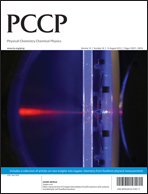Single molecule studies of calix[4]arene-linked perylene bisimide dimers: relationship between blinking, lifetime and/or spectral fluctuations†
Abstract
We recorded fluorescence time traces, and simultaneously either the fluorescence lifetime or the emission spectra from single perylene bisimide (PBI) dimers embedded in a polystyrene matrix. In these traces three distinct intensity levels can be distinguished, which reflect the photo-induced radicalisation of one of the perylene subunits. Differences in the energy transfer rate between the neutral PBI and the reversibly formed
![Graphical abstract: Single molecule studies of calix[4]arene-linked perylene bisimide dimers: relationship between blinking, lifetime and/or spectral fluctuations](/en/Image/Get?imageInfo.ImageType=GA&imageInfo.ImageIdentifier.ManuscriptID=C2CP41250K&imageInfo.ImageIdentifier.Year=2012)

 Please wait while we load your content...
Please wait while we load your content...